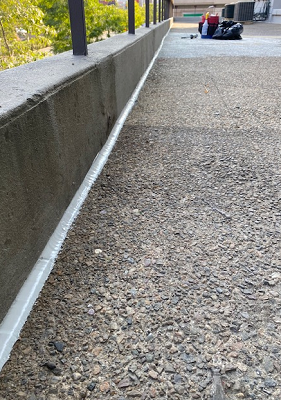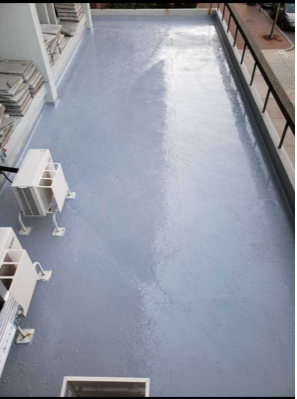Good work begets more work — at least, that’s what the team from Pierce Property Services experienced in late 2020. When working on a façade project at the Kenmore Towers in Boston, Mass., the contracting company heard about another pain point of the building owners: The building also had a mezzanine deck leaking into the lower lobby and garage. And that meant another work opportunity for Pierce!
“That façade project turned into this coating opportunity that we saw as an opportunity for them to solve another issue while we were there,” said Kyle Pierce, director and co-founder of the company.
The tower, which was built in the ‘50s, was made of cast-in place concrete. On the mezzanine deck, concrete panels were used as a base, but they just weren’t cutting it anymore. That was probably due to disintegrating caulking joints that had been between the slabs, of which the Pierce crew saw evidence.
Even though the team was already on site, this wasn’t a simple domino-type of process from one project to the other. In fact, the Pierce crew worked on both projects during the same timeframe, hopping off of the façade job and onto the deck one when they saw a good stretch of weather coming down the pike.
“The temperatures were beginning to drop, so we needed two or three days of clear, good temperatures that were above 45 [7.2 °C] for this coating to be able to go down — and that includes what happens overnight,” Pierce explained. “So we were looking ahead to the forecast while we were doing the façade and saw this stretch, and that is when we pulled and let this job take off.”
The deck project, then, was completed during a long weekend in October, thanks to the client’s support.
COVID Considerations
 The project was completed during COVID-19 times, but the crew wasn’t affected too much by any additional considerations. That’s because, for starters, they didn’t have to enter the jobsite through the building and risk running into any residents. “We didn’t need to,” Pierce said. “They had a back stairway that kind of took us up on a little pool deck, and we could walk to the front mezzanine.”
The project was completed during COVID-19 times, but the crew wasn’t affected too much by any additional considerations. That’s because, for starters, they didn’t have to enter the jobsite through the building and risk running into any residents. “We didn’t need to,” Pierce said. “They had a back stairway that kind of took us up on a little pool deck, and we could walk to the front mezzanine.”
Even so, Pierce explained that they kept in constant communication with the building’s leadership. “We’re continually communicating with the board of directors, which uniquely at this building, they didn’t have a management company,” he explained. “They have a whole board that makes decisions, with a guy who’s in charge of facilities on site.” The board relayed any messages to residents that lived near the work.
In addition to that, the crew always wears proper personal protective equipment (PPE) regardless of the pandemic, which in this case included KN95 masks, goggles, and gloves.
The crew also used a clever idea to protect their pants: They wrapped them with plastic, which helps keep any coating or other materials off. That, along with the cleats worn to avoid shoeprints in the coating, give them a, er, leg up on the competition.
Because the deck had parapet walls wrapping around the perimeter of the deck, the crew didn’t need to worry about fall protection. However, those walls did require that the crew handle the termination points of the coating system.
But first… prep!
Prep and Paint
The crew started by removing any debris, power washing to remove any spalled concrete, and caulking and chasing cracks. They grinded with diamond blades attached to vacuums with high-efficiency particulate air (HEPA) filters, and they filled those with a sealant from Sika called Sikaflex-2c SL. “That will make sure that no moisture is coming back up through the concrete once the coating goes over it, which would end up bubbling that,” Pierce explained.
Around the heating, ventilation, and air conditioning units, the crew used taping to protect them before coating. That’s “wherever we don’t want coating to splash onto them, just really for aesthetics,” Pierce explained. Up the parapet walls, the crew went 4 inches (10.2 cm) before terminating the coating system, but they didn’t use plastic or tape there. Instead, they relied on experienced crew members to get a clean edge with the guidance of a chalk line.
All of that prep work started on a Thursday, and by Friday, the crew was already installing the primer. For this system, that was Neogard’s clear urethane primer 7797/7798, applied using the seed and backroll method at 160 square feet per gallon (3.9 m2/L). All joints and cracks that had been filled also received a detail coat at this time of approximately 23 mils (584.2 microns) wet film thickness (WFT).
 The rest of the system included the FC7500/FC7960 Fast-Cure Polyurethane Base Coat at 21–23 mils (533.4–584.2 microns) WFT, another layer of that same coating at 12–14 mils (304.8–355.6 microns) WFT, and finally a layer of FC7540/FC7964 Fast-Cure Aliphatic Urethane Topcoat at an average of 18 mils (457.2 microns) WFT. They used non-angular zero sand for slip resistance, and a standard gray for the look of the system. All “consumable” application equipment came from Whitney Building Supplies in south Boston.
The rest of the system included the FC7500/FC7960 Fast-Cure Polyurethane Base Coat at 21–23 mils (533.4–584.2 microns) WFT, another layer of that same coating at 12–14 mils (304.8–355.6 microns) WFT, and finally a layer of FC7540/FC7964 Fast-Cure Aliphatic Urethane Topcoat at an average of 18 mils (457.2 microns) WFT. They used non-angular zero sand for slip resistance, and a standard gray for the look of the system. All “consumable” application equipment came from Whitney Building Supplies in south Boston.
Delivering Good Service
The true test of the success of a new waterproofing system is whether or not the coatings have done their job, and this one worked!
“The leaks stopped, so that was successful,” Pierce said succinctly. “I think the board was thrilled with the aesthetics of how it looked and how it came out, and operationally how low impact it had on the building’s operation in general.”
Pierce attributes those successes to the pre-job planning. “One of the biggest things you can do for a building is not have any impact on their operations while performing a good service,” he continued. From the sounds of it, the Pierce Property Services crew checked both of those boxes, and delivered a successful solution to the Kenmore Towers.